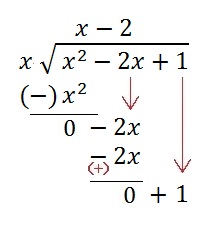How do you find the vertical, horizontal or slant asymptotes for f(x) = (x^2 - 2x + 1)/(x)?
1 Answer
Explanation:
An ASYMPTOTE is a line that approches a curve, but NEVER meets it.
To find the vertical asymptote , put the denominator = 0 (because 0 cannot divide any number) and solve.
Here,
The curve will never touch the line
Next, we find the horizontal asymptote:
Compare the degree of the expressions in the numerator and the denominator.
Since,
There are
The oblique asymptote is a line of the form y = mx + c.
Oblique asymtote exists when the degree of numerator = degree of denominator + 1
To find the oblique asymptote divide the numerator by the denominator.

The quotient is the oblique asymptote.
Therefore, the oblique asymptote for the given function is

